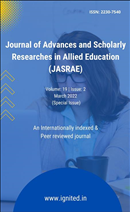A Study the Ecosystem Services (ES) of Industries and Urban Green Spaces
Keywords:
Urban Green Spaces, Ecosystem, Industries, Cultural, NagpurAbstract
This research was done to better understand the supply and demand for important ecosystem services, with a particular emphasis on the supplying, controlling, or cultural ecosystem services (ES) that the people of Nagpur City, a quickly developing urban center in Central India, utilize. In order to create a thematic map based on people's perceptions of demand and supply gaps in access to public urban green spaces (UGS), the study investigated participative tools. The participatory survey's goal was to learn about people's needs, the public UGS's accessibility and availability, & essential ES they were using. Urban planners & policy makers can use this information to gain a general understanding of Nagpur's green space availability & distribution. An inventive tool that has proven successful for documenting qualitative status, examining spatial distribution, and ranking UGS offerings is participatory mapping methodology. Incorporating participatory methods into geographic data can expand the advantages of UGS offerings. With the purpose of guaranteeing future urban sustainability through suitable & planned green infrastructure, these instruments aid in improved UGS governance.
References
Appannagari, R. R. (2017). Environmental pollution causes and consequences: a study. North Asian International Research Journal of Social Science & Humanities, 3(8), 151-161.
Bansal, N. (2018, March). Industrial development and challenges of water pollution in coastal areas: The case of Surat, India. In IOP Conference Series: Earth and Environmental Science (Vol. 120, p. 012001). IOP Publishing.
Bhar, C. (2016). Indian textile industry and its impact on the environment and health: a review. International Journal of Information Systems in the Service Sector (IJISSS), 8(4), 33-46.
Duhan, D. and Pandey, A. (2013) 'Statistical analysis of long term spatial and temporal trends of precipitation during 1901-2002 at Madhya Pradesh, India', Atmospheric Research. Elsevier B.V., 122, pp. 136–149. DOI: 10.1016/j.atmosres.2012.10.010.
Joshi, N. et al. (2016) 'Analysis of trends and dominant periodicities in drought variables in India: A wavelet transform based approach,' Atmospheric Research. Elsevier B.V., 182, pp. 200–220. DOI: 10.1016/j.atmosres.2016.07.030.
Salas, S. and Araya, A. (2018) 'Climate Change Adaptation in Latin America' (January 2017), pp. 305–320. DOI: 10.1007/978-3-319-56946-8
Saviour, M. N. (2012). Environmental impact of soil and sand mining: a review. International Journal of Science, Environment and Technology, 1(3), 125-134.
Secretariat, R. S. (2008) Climate Change : Challenges To Sustainable Development in India. New Delhi.
Surawar, M.; Kotharkar, R. Assessment of Urban Heat Island through Remote Sensing in Nagpur UrbanArea Using Landsat 7 ETM+. Int. J. Civ. Environ. Struct. Constr. Archit. Eng. 2017, 11, 851–857.
Uttara, S., Bhuvandas, N., & Aggarwal, V. (2012). Impacts of urbanization on environment. International Journal of Research in Engineering and Applied Sciences, 2(2), 1637-1645.
Verma, S.R.; Chaudhari, P.R.; Singh, R.K.; Wate, S.R. Studies on the Ecology and Trophic Status of an Urban Lake at Nagpur City, India. Rasayan J. Chem. 2011, 4, 652– 659.
Wang, Q., Su, M., & Li, R. (2018). Toward to economic growth without emission growth: The role of urbanization and industrialization in China and India. Journal of cleaner production, 205, 499-511.








